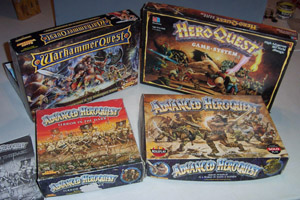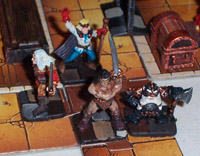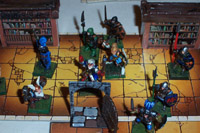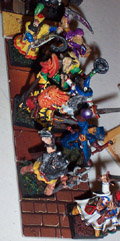|
So, what is Advanced HeroQuest? I have a very limited knowledge of its history, but here's an attempt to chronicle what little I know....
A Very Incomplete History
Games Workshop has put out several fantasy games, including "Warhammer Fantasy Battle" - a war game set in the "Warhammer" fantasy world. Earlier editions of the game had a lot of similarities to certain other fantasy settings of the time, though it generally had a darker and more grim outlook. There were humans, dwarves, elves, halflings, orcs, goblins, giants and dragons to be found in the Old World.
The particulars of the setting have evolved over time. Along the way, the "Warhammer Fantasy Role-Play" game was developed, an RPG offshoot of the popular miniatures wargame. (It can still be found today, thanks to a brief revival by Hogshead Publishing, by special arrangement with Games Workshop.)

(Upper left: Warhammer Quest. Upper Right: HeroQuest. Lower Right: Advanced HeroQuest. Lower Left: "Terror in the Dark" supplement for Advanced HeroQuest.)
|
In 1989, Games Workshop created "HeroQuest". In the United States, it was released by Milton Bradley Games, as a fantasy "game system" that allowed players to take on the roles of the Elf, the Dwarf, the Barbarian, or the Wizard, with a fifth player taking on the role of the Game Master (or "Zargon" the evil sorcerer). The same year, "Advanced HeroQuest" was available in the United Kingdom - a game bearing some superficial similarities to HeroQuest, but having its own, somewhat more sophisticated system. (All the same, there is at least a tip of the hat to HeroQuest, in that rules are included in Advanced HeroQuest on how to "convert" the "High Elf", Dwarf, Barbarian and Wizard over to this new system, and how to make use of the labyrinthine board and furniture pieces.)
The setting introduced in Advanced HeroQuest is similar to that of the 4th edition incarnation of the Warhammer Fantasy Battle game. The "Colleges of Magic", not present in the Warhammer Fantasy Role-Play Game, are distinguished and developed into eight different "colleges", each assigned to a different "wind" on a compass rose. While there are orcs and goblins and such in this setting, they are far more alien than before - some sort of humanoid fungus, rather than just a green-skinned goblinized breed of humankind. The primary enemy in this setting is the encroaching, reality-warping power of Chaos, as exemplified by the four mighty Chaos Gods ... and the primary enemy presented in the Advanced HeroQuest boxed set would be the rat-like Skaven.
|
The Boxed Set

(A small sample dungeon layout, with dungeon tiles, plastic hinged doors, cardboard markers, "Skaven" warriors and plastic "Henchmen" from Advanced HeroQuest. The 3-D furniture pieces and several of the plastic miniatures are from the Milton Bradley HeroQuest game.)
|
The original boxed game included plastic miniatures and door pieces, die-cut dungeon tiles and markers, a couple of 12-sided dice, and a softcover rulesbook. The miniatures included models of the 4 Heroes (Human Warrior, Human Bright Wizard, Dwarf and Elf), 12 Henchmen (hirelings), and 20 Skaven Warriors. Six plastic doors had rather clever - but unfortunately fragile - hinges that allowed the doors to be opened or closed. (These same doors also appeared in another Games Workshop product, the "Dungeonbowl" expansion for their fantasy football game, "Bloodbowl".)
Die-cut dungeon sections were a major feature of this game. In addition to larger square, rectangular or circular dungeon rooms, there was a whole system of "puzzle-locking" passages, T-junctions, intersections and corners (with a couple of "stairs" pieces), plus colorful markers to represent traps, treasure and other features to fill the dungeon.
The game could be played in several ways. As advertised on the box, it was possible to engage in "solo play", playing the game like an elaborate sort of fantasy Solitaire - randomly generating dungeon layouts by die rolls and the consultation of charts, and following strict rules for the actions of monsters that the player could have his heroes oppose. Similarly, up to four players (or, for that matter, more, provided some extra miniatures were provided) could play this like an elaborate board game, with the "winner" being determined by who managed to accumulate the most gold in the dungeon.

(Heroes from the original HeroQuest game - Dwarf, Elf, Barbarian, and Wizard.)
|
Character sheets were provided for each of the four main characters - as well as conversions for the four heroes from "HeroQuest" - and blank sheets could be photocopied on the back, with rules for randomly generating statistics for new Heroes.
The real potential for the game, however, is when it introduces the role of the Game Master. All of the charts and meticulous rules for dungeon generation and monster behavior can be set aside, so long as one person is willing to be the Game Master, to come up with a story and an adventure for the heroes, to play the part of the monsters (and any other characters the Heroes might encounter), and to serve as the narrator and referee for the proceedings. Even with the introducing of the Game Master, the rules are still heavily biased toward resolving so many things by charts and random chance, but it's a fairly simple matter for the Game Master to steer things in a more deterministic direction.
|
Game Play
Game play in Advanced HeroQuest is fast and simple, when compared to most "traditional" roleplaying games. Character statistics are simplified to the point where a basic "character sheet" fits on just half of a 8.5"x11" page, with room to spare for a large character portrait and decorative frills. The only die type used is the 12-sided die; while two are included with the game, it is best to have several handsful to play the game properly.
Many skill rolls are handled with a single die roll, while such things as damage are handled with a whole handful of dice, and a threshold system. (That is, damage is handled by rolling a handful of dice. See which of the dice meet a certain target number or higher. Remove all those that fail to meet this threshold. Then, count the remaining dice to determine how many "hits" are scored.) For different parts of the game, sometimes it's advantageous to roll high, and sometimes low, so it minimizes the impact of a "lucky" (or weighted) die on the game.
Play is simple, but often lethal - for Heroes as well as monsters. It is quite possible for even the lowliest goblin to slay the mightiest barbarian, due to the open-ended system of "Criticals" and "Fumbles" worked into the die-rolling exercises. This is somewhat muted by the introduction of "Fate Points" to the game: each beginning Hero starts with two Fate Points, which may be spent as a sort of "get out of jail free card". That is, they can be spent to turn an unsuccessful die roll into a successful one, or else to totally negate all of the damage that a Hero has taken in a single Turn. As a Hero completes adventures, he gains more Fate Points, which greatly increase his chances of survival - and for each new expedition, his Fate Points are restored to their maximum once more. Once he runs out of Fate Points, however, his luck has pretty much run out, and he's suddenly very vulnerable.

(Heroes from the Advanced HeroQuest game, as well as an assortment of Henchmen - some of them "kitbashed" with accessories from other plastic Games Workshop sets. The Heroes consist of the Dwarf, the Elf, the Wizard, and the Warrior.)
|
Another feature of the game is that of Henchmen. In the basic game, Heroes can hire Henchmen and Henchman Sergeants to accompany them into the dungeon. These are additional models under the player's control, giving extra fighting power - and an extra buffer against the enemy. Henchmen cost gold to recruit, and - like the Heroes - they have "living expenses" they must pay in between adventures ... or else they'll be forced to leave the employ of the Heroes. The Henchmen are far more vulnerable than the Heroes, and thus this role has a high turnover rate. Nonetheless, it gives an interesting room for character advancement for the Heroes, beyond mere personal increase in physical or intellectual power: the Heroes can become leaders of small "armies" of warriors in the battle against Skaven, Orcs, Undead, and other servants of Chaos.
With the high mortality rate amongst Heroes, Henchmen provide another valuable role: if a Hero should die in the middle of a scenario, the player can at the very least keep playing any surviving Henchmen, rather than leaving the game entirely. (In fact, some of the special Henchman types might even work well as new types of Heroes.)
|
Campaigns
It's possible to have long-running campaigns in the Advanced HeroQuest system, though not always easy. This game system tends to have a very high mortality rate compared to more "traditional" RPGs. Character advancement is in part based upon experience (Fate Points gained by completing adventures), and in part upon treasure gained (as Gold Crowns are spent on "training" to increase statistics, or on better equipment). Unlike some systems, there's no experience to be gained by slaying monsters, so there can actually be good cause to sneak past or even try to outwit them, rather than resolving everything in a fight. (Still, monsters often have gold, and this is a very combat-oriented game, so it is a rare adventure indeed where a truly peaceful resolution is possible.)
Unfortunately, character advancement is one of the real weak points of Advanced HeroQuest. Beginning Heroes tend to have a high mortality rate, but once they accumulate enough Fate Points, those start to be a greater measure of player survival: suddenly, Heroes are confident that they can face any danger ... until their Fate Points run out, and then it's time to head back to town. With scores only running from 1 to 12, there is a limited range for advancement, and a great deal of a character's potential simply depends on how lucky the player was when first rolling his statistics. While it's indeed possible to run some satisfying series of adventures using the same characters, power balance between different characters and classes become more pronounced as the Heroes gain more Fate Points, accumulate magical items, and advance in ability.
|
Expansions

(Miniatures representing the eight Colleges of Magic - including plastic miniatures originally produced for the
"Talisman" board game.)
|
A single spell list is included in the basic set, for use by the Heroes - the Bright College (fire magic) spell list. Unfortunately, this is another failing of the game: in presenting this as the only spell list available to the Heroes in the basic game set, the Bright College spell list is therefore very much a spell list for a "jack of all trades" sort of spellcaster. Not only does it contain a destructive "fire ball" type of spell, but also a spell of healing - and, later, even to resurrect characters.
Another supplement, Terror in the Dark, presents new dungeon tiles, a new adventure (in which the Undead are the enemy), and a new spell list - the Light College, for the Light Wizard (also known as a Priest). The Light Wizard's spell list seems to be inspired partly by the role of "clerics" in certain other fantasy RPG settings, but since the Bright Wizard already has one of the most important facets of this role (healing) covered, it's not quite as distinctive as it could be.
Other innovations in the rules include the introduction of new Henchman types - the Captain (who serves Human Warriors), the Troll Slayer (who will follow a Dwarf Hero), the Wardancer (who will follow an Elf Hero), and the Apprentice (who would follow a Wizard Hero). The Wardancer and Troll Slayer can even work as alternate Heroes for the players to try out for one-shot games, so long as the pre-generated statistics are used. (They have additional abilities, but this is offset by the fact that they each only have a single Fate Point to spend.)
Additional supplements in the pages of White Dwarf (Games Workshop's house organ magazine) present new features - new monsters, new adventures, and a couple of new spell lists. (Of the latter, this would include the "Amethyst College" list, which basically fills the role of a "mentalist" - and the "Jade College" list, which presents a spellcaster who fits a somewhat "druidic" role.) The remainder of the Colleges of Magic are never covered in any further supplements - and by the time Advanced HeroQuest's successor comes out ("Warhammer Quest"), it seems that the concept of Colleges of Magic is abandoned entirely, instead bringing up the ideal of a "jack-of-all-trades" wizard once more.
|
Today

(Hero models from Warhammer Quest: the Barbarian, Wizard, Wood Elf, and Dwarf.)
|
Advanced HeroQuest went out of print in 1994 - and shortly thereafter, in 1995, it was replaced by a new game, also set in the lands of the Old World: "Warhammer Quest". Although Warhammer Quest bore many similarities to Advanced HeroQuest (lots of plastic miniatures, Heroes fighting in dungeons and obtaining treasure, cardboard dungeon tiles, plastic doorways), it was a completely different and incompatible system. No attempt was made to "convert" any of the material from Advanced HeroQuest to the new system.
Expansions were produced for Warhammer Quest, but ultimately it fell by the wayside as well. As of this writing, there are no plans indicated to revive Advanced HeroQuest (or anything like it) in the near future. Nonetheless, Games Workshop still retains the rights to the game. At present, the only way to obtain the game is to keep an eye out on online auctions and the like, in case a boxed set surfaces for sale.
That's not to say that the game is dead and gone. I often run "one-shot" scenarios using this system, and I occasionally even try to run a campaign. Over the course of time, I've developed new spell lists, new monsters, new Hero types, and even a few adventures, and the main purpose of this site is to share some of that material to others who are likewise interested in this game.
|
|




